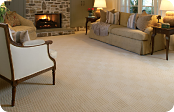Home Contact us Ceramic Laminated Hardwood Vinyl Carpet
Call or Text: (214) 986-0424
About Carpet flooring
Today's carpet offers a wide variety of choices in style, fiber composition
and color. Gone are the days of having to select only conventional cut
or loop
pile. New technology can produce multilevel loop and cut-loop patterns allowing
diamond, bow, pin dot or fleur-de-lis designs that "pop
out" in sculptured effects.
The texture, colors and pattern of the carpet can complement or contrast with
patterns of your furniture and window treatments. Using a solid color, textured
carpet is a great way to provide interest and pizzazz, without going to a multicolor,
overall pattern. Textured carpet styles also fit well with today's active and
casual lifestyles.
Buying Tips for Carpeting.
Before selecting the perfect carpet for any room, there are a couple of key questions
you'll need to ask yourself:
Is there light or heavy traffic in the room? As a general rule of thumb, for
heavy traffic areas such as stairways and halls you should buy the best quality
carpet you can afford. For areas where traffic tends to be a little lighter,
like a bedroom, a medium grade carpet might work just fine for you.
Do you have children? Carpet can be a nice, comfy choice for kids because they
tend to spend a lot of time on the floor. On the other hand, children are also
extremely hard on carpeting. So you'll want select something very durable. Durability
is generally achieved by the type of fiber, density of tufts, and amount of yarn
twist. Huh? The friendly folks at Carpet Exchange will gladly help you sort all
this out.
Do you have pets? If
you have a dog named "Spot "because he tends to be a little accident prone, then maybe you don't want to
invest in top-of-the-line carpeting for any room he'll be spending a lot
of time in. Please also keep in mind, while a looped carpet may be great
fun for your cat, it's not very much fun for the carpet.
Is the room used for dining? For rooms that are used for dining, you need to
consider who's going to be doing that dining. If it's mostly grownups, it's okay
to go ahead and order the most expensive, formal carpet on the menu. Then again,
if little ones are involved, you'll need a carpet that can stand up to stains
and spills.
Natural:
Wool - is, of course, a natural fiber. Its high bulk gives it a soft feel.
Although available in a broad range of colors, bright colors are not common
(ever seen a fuchsia sheep?). Generally the cost of wool is higher than synthetics.
Man-made fibers:
Nylon - one of the most popular choices. It is wear-resistant, resilient and
available in a broad range of colors -from neutrals all the way to the very
brightest of hues. It is also known for its ability to resist stains and conceal
soil.
Polyester - the touch is soft, but not as resilient as nylon. Better in low
traffic areas.
Olefin (polypropylene) - resists wear, permanent stains, moisture, static electricity,
and is easily cleaned. Used in indoor/outdoor carpeting.
Acrylic - has the appearance and feel of wool at less cost. Because of its
resistance to moisture and mildew it is often used to produce bath and scatter
rugs. Many level-loop carpets utilize this fiber. It's no shock: it also has
a low static level.
Common construction
techniques:
Saxony - a level cut pile in which the yarn loops form a densely-packed, smooth,
luxurious surface. This creates a more formal appearance.
Plush - the yarn is again cut level but not nearly as dense as a saxony. A
little less formal in look.
Texture - the yarns are curled or twisted giving a textured appearance and
a decidedly less formal look. A key advantage of textured carpet is that it
minimizes footprints.
Cut-Loop - this is made up of a mixture of higher cut tufts and lower loop
tufts to form a sculpted pattern in the carpet.
Level Loop - this carpeting is made up of looped tufts all of equal height.
Because of its durability, this style is particularly good in high traffic
areas. The berber style is characterized by larger loops.
Multilevel Loop - two or three levels of looped tufts form a random sculpted
pattern.
Frieze - highly twisted yarns that curl at the pile surface. This style is
a steady, sturdy performer in high traffic areas.

